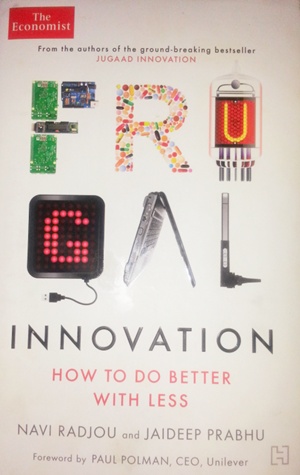Frugal Innovation: the art of doing more with less
24 Apr 2015
 Navi Radjou is an innovation and leadership advisor based in Silicon Valley. He has won the 2013 Thinkers50 Innovation award and spoke at TED Global 2014. He is the former Vice President at Forrester Research in Boston and San Francisco. He has also consulted for leading global firms including BAE Systems, BP, Cisco, E&Y, Fujitsu, GM, Hitachi, IBM, Microsoft, P&G, Rolls-Royce, SAP, TCS and Wipro.
Navi Radjou is an innovation and leadership advisor based in Silicon Valley. He has won the 2013 Thinkers50 Innovation award and spoke at TED Global 2014. He is the former Vice President at Forrester Research in Boston and San Francisco. He has also consulted for leading global firms including BAE Systems, BP, Cisco, E&Y, Fujitsu, GM, Hitachi, IBM, Microsoft, P&G, Rolls-Royce, SAP, TCS and Wipro.
 Jaideep Prabhu is Jawaharlal Nehru Professor of Indian Business and director of the Centre for India & Global Business at Cambridge Judge Business School. He has consulted for or taught executives from Barclays, Bertelsmann, BP, BT, GE, IBM, ING Bank, the NHS, Nokia, Philips, Shell, Siemens, Vodafone and Xerox, among others.
Jaideep Prabhu is Jawaharlal Nehru Professor of Indian Business and director of the Centre for India & Global Business at Cambridge Judge Business School. He has consulted for or taught executives from Barclays, Bertelsmann, BP, BT, GE, IBM, ING Bank, the NHS, Nokia, Philips, Shell, Siemens, Vodafone and Xerox, among others.
In this interview with Swetha Amit, they talk about the success of their first book, the novel concept of 'frugal innovation', which is also the title of their new bestseller, and what makes this concept sustainable in several organizations.
Your first book Jugaad Innovation was a runaway success. Did you ever anticipate such an enthusiastic response when you initially worked on it?
Quite frankly the runaway success of Jugaad Innovation took us by surprise! In India alone, the book has crossed the 70,000-sales mark. In retrospect it's now clear that Jugaad Innovation was, and is, an idea whose time has come. We can probably attribute the success of the book to the fact that India and the world are doing, and need to do more of, this frugal, flexible and inclusive kind of innovation.
Your new book emphasizes on the concept of 'frugal innovation'. Could you tell us a little more about it and its benefits?
Jugaad Innovation was all about frugal innovation in emerging markets like India, China, Brazil and Africa, and what Western multinationals wishing to compete in emerging markets could learn from this approach. Ever since Jugaad Innovation was published in April 2012, we began to see increasing interest in frugal innovation in the West for the West. And so the new book is about that new phenomenon.
Frugal Innovation is really about how to do more, and better, with less. It is about how companies can generate more economic and social value (for customers, shareholders and society) using fewer resources (such as energy, water, time and money). In the book we explore 6 key principles that underpin frugal innovation, and discuss at length how companies can create a frugal innovation culture that helps them and the societies they operate in do more, and better, with less.
Your book mentions about the shift in attitude from 'bigger is better' to 'small is beautiful'. What has led to this sudden transition?
The 20th century model for innovation was an industrial one. Companies set up large R&D teams with huge budgets that worked on long-term projects. The idea was ''let's use technology to differentiate our products from competition and pass on the costs to consumers''.
Over time this approach led to a focus on technology for the sake of technology, which in turn increased the costs of innovation (including the cost of failure). But the world has changed dramatically in the last decade or so. Consumers are now more empowered than ever before and don't want (and are unwilling to pay for) over engineered products that don't fit their needs and budgets.
Further smaller, hungrier companies are now empowered to do with limited resources what only large companies with huge budgets could do in the past. Now small teams can quickly co-create solutions with consumers.
Using tools such as 3D printers, cloud computing, and cheap software companies can frugally and flexibly develop, test and refine products and services that are better suited to the needs and budgets of consumers. And with the help of crowdfunding, outsourcing of manufacturing and social media they can also scale these solutions up fast. In this brave new world of the 21st century, small is not exactly beautiful, but it is increasingly quick and successful! And even large firms can adopt or mimic these processes within their complex organisations. This is what our book outlines for firms.
The concept of frugal innovation, which talks about doing better with less can cause great concern for marketers as it can be equated to poor quality at times. How do managers ensure that the corporate brand is not affected in such a scenario?
In our book we argue and show that frugal innovation isn't about doing less for less. Rather it is about doing more and better with less. So rather than do something of poorer quality at a lower cost (which is pretty straightforward to do), our book is all about how to do more, and better, at a lower cost.
The clash with brand, quality and the focus of marketing managers does not therefore exist. Nevertheless, it is possible that simply because a product is cheaper, consumers may assume it is therefore of poorer quality. This is where the firms that offer affordable products to the marketplace need to emphasise their value for money, using all the tools of the marketing mix: product (including branding, design and packaging), promotion (including advertising), price and place (or distribution).
Several of the principles we outline in the book, and therefore several of the chapters in the book, describe precisely how firms and managers can ensure that frugal innovation, rather than eroding a brand, can help fortify and build it.
How do you create sustainability when it comes to frugal innovation? Do you think Corporates need their business models like what 'Tarkett' did? Given that 70 per cent of a product's lifecycle costs are determined during its design, sustainability begins during the R&D phase of a product. That's why several leading companies such as Levi Strauss, Philips, and Unilever are adopting ''eco-design'' principles like ''cradle-to-cradle'' (C2C) to develop frugal products in such a way they minimise use of natural resources and energy during their manufacturing, distribution and maintenance.
Given that 70 per cent of a product's lifecycle costs are determined during its design, sustainability begins during the R&D phase of a product. That's why several leading companies such as Levi Strauss, Philips, and Unilever are adopting ''eco-design'' principles like ''cradle-to-cradle'' (C2C) to develop frugal products in such a way they minimise use of natural resources and energy during their manufacturing, distribution and maintenance.
For instance, Levi Strauss recently has created jeans that can be manufactured using fewer natural resources. The "Levi's Water<Less" collection, launched in 2011, uses up to 96 per cent less water for some styles than regular jeans do during the finishing process. Each pair is processed using only 1 litre of water. Levi Strauss has already produced 62 million items using its Water<Less process, which it claims has saved over 770 million litres of water (enough to fill 308 Olympic-sized swimming pools).
Similarly, Unilever's R&D has developed concentrated detergents that can be sold in smaller packages. The smaller pack sizes reduced distribution costs, allowing Unilever to cut its truck fleet by 20 per cent. The innovation resulted in reductions in transport, packaging and waste to landfills, and much of the savings can be passed on to consumers.
Ultimately, instead of just redesigning a few eco-friendly products, companies need to reinvent their entire business model around sustainability. That's what Paul Polman, CEO of Unilever (who wrote the foreword for our book) has done by having announced in 2010 his plan to double his company's revenues by 2020 while reducing environmental impact by 50 per cent during same time period.
Tarkett, a world-leader in flooring solutions, is also radically reinventing its entire business model around sustainability. By 2020, Tarkett aims to become a ''circular enterprise'' – i.e, it intends to use 75 per cent of renewable and recycled materials, eliminate industrial waste going to landfill, make sure that all flooring products are made from phthalate-free plasticisers and have low TVOC [total volatile organic compounds] emissions, and collect and recycle a large volume of post-installation and post-consumer products.
How much of a role does customer demand for eco-friendly products play a part in boosting frugal innovation?
Customers now pay more attention to what they consume. For instance, 61 per cent of EU citizens worry that pollution is damaging their well-being, and 42 per cent are concerned about the harmful effects of poor air, food and products.
Interestingly, according to research and opinion agency Nielsen, 55 per cent of consumers worldwide are willing to pay extra for products that have been developed in a socially and environmentally responsible way. So clearly customers – especially the Generation Y -- are clamoring for eco-friendly products.
And, they want companies to play their part in protecting the environment. For instance, 74 per cent of Americans agree that a manufacturer that reduces the environmental impact of its production is making a smart business decision.
You have mentioned that the C2C design being essential for frugal innovation. Could you elaborate your reasons for this?
Cradle-to-cradle (C2C) is a design philosophy that aims to design products in a way their content can be recycled entirely at the end of their life to make new products. As raw materials like wood become scarce, companies must adopt C2C design principles to make the most of limited resources.
Take Kingfisher, Europe's largest home improvement retailer. Kingfisher's annual wood consumption is equivalent to a forest the size of Switzerland. To address growing scarcity of wood and other raw materials, Kingfisher is implementing a frugal innovation strategy called Net Positive. As part of this strategy it is using C2C to redesign all its 40,000 products to make them more sustainable. They call these ''closed-loop'' products.
Closed-loop products are made mostly from recycled or renewable materials and consume only renewable energy during their manufacture and use. When they break or get old, materials and parts from these products can be collected to make new products.
You have mentioned how CEOs should behave frugally to inspire customers as in the case of Levis Strauss. How should leaders build the culture for frugal innovation in organizations?
To inspire and galvanize all employees to achieve breakthrough frugal innovation, and cultivate a frugal culture, leaders must set the bar high by committing the entire company to a "big, hairy audacious goal" (BHAG), such as ''100 per cent of all our products will carry an external sustainability certification within ten years'' (the BHAG of Marks & Spencer's extended Plan A announced in 2010) or ''to have zero environmental footprint by 2020'' (a BHAG that a leading carpet-maker has set for itself as part of its Mission Zero).
The BHAG must be highly ambitious, otherwise the initiative risks ending up as a series of minor, incremental and insignificant changes. Companies should then run big marketing campaigns that emphasize these BHAGs to encourage organisation-wide commitment and stimulate major cultural change, with the risk of losing face if the publicly announced goals are not met. BHAGs also help create positive constraints that shift perceptions of frugality from being painful to being a source of disruptive and meaningful innovation.
A sense of urgency also helps. If necessity is the mother of invention, then scarcity is its grandmother. Constantly communicating the need to change now or lose badly tomorrow is crucial in getting employees to commit to change. But this is not enough. Intrinsic motivation factors such as ''I am doing the right thing'' or ''I am helping save the planet'' alone cannot sustain organisation-wide mindset and behaviour change. Extrinsic motivation factors such as rewards and incentives are also needed to ensure that employees remain fully engaged with the change process. Leaders must therefore set up organization-wide incentive systems based on Key Performance Indicators (KPIs) to reinforce new behavior.
What are your future plans over books on similar concepts?
We don't plan to co-author and publish more books in the short-term, but in the coming months we do intend to jointly research and publish case studies on companies implementing frugal innovation in specific industries (eg, finance, manufacturing, retail, healthcare, education) and explore the role of frugal innovation in the public sector as well.
(See: Book excerpt from Frugal Innovation: Principle three: create sustainable solutions)













.jpg)






.jpg)









